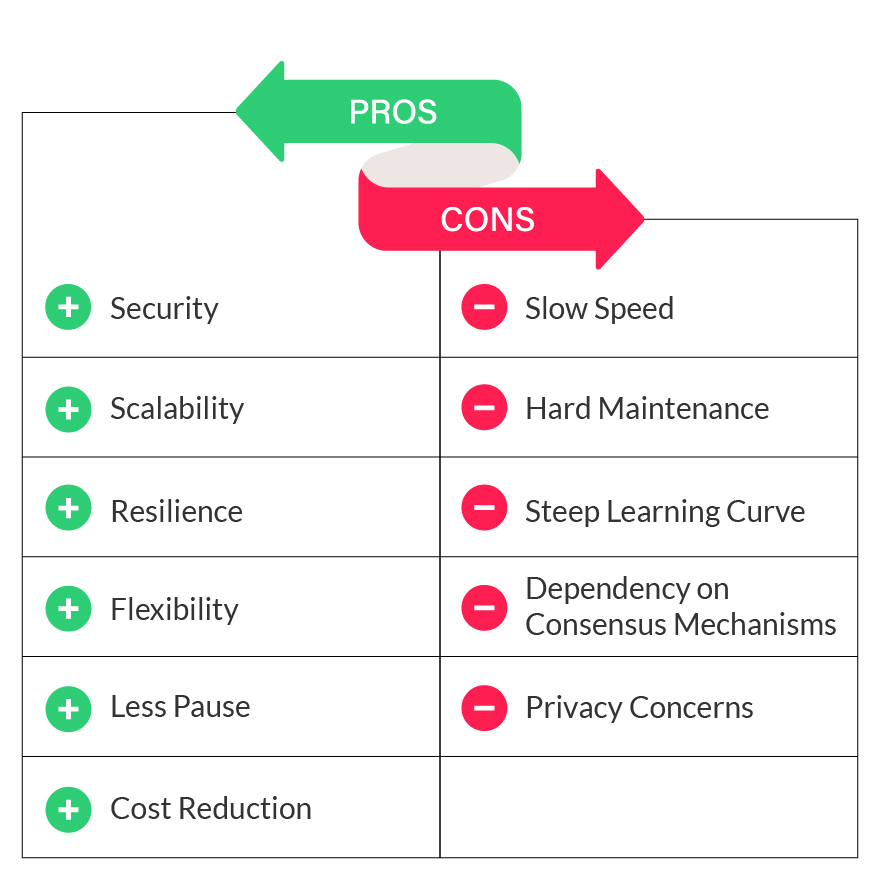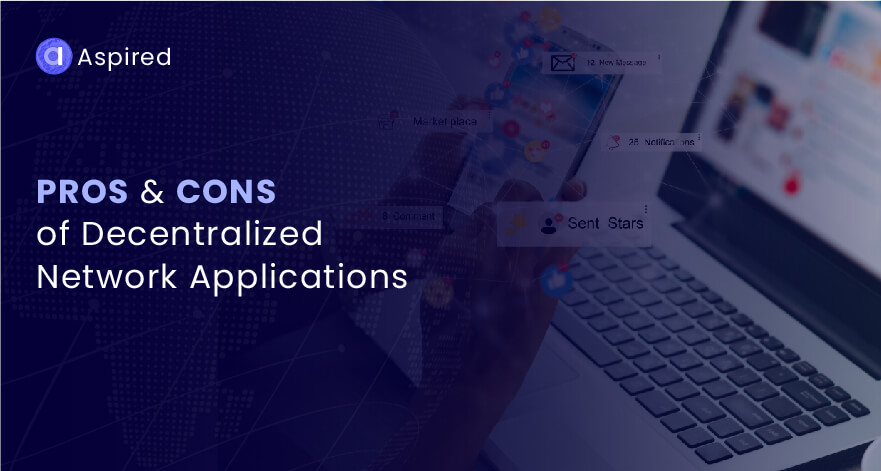As blockchain becomes more prevalent across industries worldwide, new technological developments are being introduced every single day to improve convenience and efficiency to become acceptable to users and organizations like.
One of these is the development of decentralized applications, or dApps – that have quite become a buzzword in the crypto world. dApps, unlike the normal apps of use, are developed on decentralized technology such as blockchain, where it receives and processes the data by blockchain. The core of dApps is their decentralization which means no centralized server/entity/authority and hence no single point of failure.
Decentralized network apps have become increasingly popular in recent years, as they offer users the ability to connect and interact with each other without relying on a centralized platform or third-party service. These apps can provide users with various benefits, including improved privacy, increased security, and greater control over their data.
The decentralized nature of these apps makes them ideal for projects requiring a distributed system or collaboration from multiple users. By leveraging the power of decentralized networks, developers can create applications that are much more resilient, secure, and efficient than their centralized counterparts.
This write-up discusses the concept of decentralized network applications, how they differ from centralized apps, their benefits, and the possible challenges they face.
What are Decentralized Network Applications?
Decentralized network applications, or DApps, are software applications that run on a distributed network instead of a single server. This emerging technology has the potential to revolutionize the way businesses and individuals interact with the internet. DApps use peer-to-peer technology to allow for a decentralized environment in which users can interact without a centralized authority, thereby increasing the security, autonomy, and trust between parties.
At their core, dApps are software programs that run on a distributed network or decentralized platform instead of relying on a single server. This means there is no single point of failure or vulnerability, providing greater security and scalability. The code behind a dApp is open-source and publicly auditable, allowing for increased trust and transparency between users and developers.
According to Market Report , the Dapps Market Size was valued at USD 10.52 Billion in 2019 and is anticipated to touch USD 368.25 Billion by 20227 at a CAGR of 5601%. The rise in the demand for decentralized applications is the result of Dapps' promise to fast transactions, transparency, scalability, and equal autonomy.
Dec decentralized network applications provide a secure, cost-effective solution to many businesses and organizations. However, they come with their own set of pros and cons that must be considered before deploying them in any setting.

The Advantages of Decentralized Network Applications
The decentralized network model has become an increasingly popular option for many applications thanks to its numerous benefits. A decentralized network is one in which all system components are connected directly to each other, as opposed to a centralized system in which components are connected through a central server.
Security: Without a central server, it's much harder for hackers access sensitive data. In addition, decentralized networks often employ encryption technology and other measures to ensure that data remains safe and secure.
Scalability: By eliminating the need for a central server, server-side resources are freed up, meaning that additional user-traffic can be accommodated without needing to upgrade hardware or make any major changes to the system, makingit easier to manage large-scale projects, especially those that require frequent updates or expansions.
Resilience: Since there is no single point of failure, if one component of the network fails, the system can remain operational as long as the other components remain operational. This makes decentralized networks much less vulnerable to outages or disruptions in service.
Flexibility: Without a centralized server, users have more control over their data and can make modifications or updates without needing permission from a centralized authority, allowingusers to customize their experience and even create their own applications using the network.
Less Pause: Unlike centralized apps, these applications don't rely on a single server and tend to be highly flexible and speed optimized, allowing enterprises to avail minimum interruption and downtime when interacting with the network.
Cost Reduction: Unlike centralized systems, which demand expensive server installation costs and professional server management and maintenance. This decentralized application eliminates the expense of the network.
The Challenges of Decentralized Network Applications
There are a few drawbacks worth considering when it comes to decentralized network applications.
Slow Speed: One of the primary drawbacks of using decentralized network applications is their relative lack of operation speed compared to centralized networks. This can be especially evident when dealing with large amounts of data or real-time applications. This can be a major issue for high-speed applications, such as online gaming or financial transactions.
Hard Maintenance: Maintaining a decentralized network application can be much more challenging than maintaining a centralized system; because decentralization requires more nodes and, thus, more maintenance tasks. Keeping each node up to-date and secure can be a difficult and time-consuming task.
Steep Learning Curve: Another con of decentralized network applications is that they can be hard to use for the un-initiated as users need to understand how the network works and how to interact with it in order to get the most out of it. As such, it may take some time for users to become comfortable with the technology.
Dependency on Consensus Mechanisms: Decentralized networks also rely heavily on consensus mechanisms in order to function properly. This means that if there is any disagreement within the network, it can cause disruptions and errors. As such, it is important to ensure that all nodes agree before making any changes or implementing any new features.
Privacy Concerns: The decentralized nature of these networks means that users' data is shared across multiple nodes, making it difficult to ensure that user data is kept secure. This could lead to privacy violations and potential abuse of user data.
While decentralized network applications have some potential drawbacks, the pros outweigh the cons. With the proper understanding and implementation, decentralized networks can offer significant benefits to businesses and users alike.
Some of the Popular Examples of Decentralized Apps
Decentralized apps (or "dapps") run on a decentralized network, such as a blockchain or distributed ledger. Examples of popular dapps include Pancake Swap, Unity, and OpenSea. All of these dapps are powered by underlying blockchain technology, which provides users with a secure, trustless environment in which to interact.
OpenSea
OpenSea is a marketplace for digital art, crypto collectibles, and gaming items. It's an open, secure, transparent marketplace for non-fungible tokens (NFTs). With OpenSea, one can buy, sell, and auction off digital goods with a secure and trustless process. One can also explore and discover different NFTs and find unique items to purchase.
Golem
Golem is an artificial intelligence system created by the Golem Network. It enables anyone to rent out their computing power or acquire it to complete almost any computing task. By leveraging the sharing economy, Golem provides a way to access a global computer network and use their combined power. With Golem, users can quickly and securely create distributed applications, like rendering and AI processing. Golem can also be used for scientific research, distributed computing, and other tasks requiring much computing power.
UniSwap
UniSwap is a decentralized exchange (DEX) protocol that allows users to trade Ethereum-based tokens without needing to trust a third party. It uses automated market makers to enable the exchange of tokens, allowing users to trade without needing to wait for an order to be filled. It also has a low fee structure which makes trading cost-effective.
PancakeSwap
PancakeSwap is a decentralized exchange for swapping tokens built on the Binance Smart Chain. It allows users to easily exchange tokens with low fees and fast transaction times. It's a great platform for users who want to trade their BEP-20 tokens quickly and securely. PancakeSwap has a user-friendly interface that allows seamless token swaps without signing up for an account.
CryptoKitties
CryptoKitties is a popular blockchain-based game that allows players to collect, trade, and breed virtual cats. Each CryptoKitty has unique attributes, and players can use Ethereum to purchase and trade these digital cats. CryptoKitties is a fun and interactive way to learn about blockchain technology, and it's a great way to get involved in the emerging blockchain gaming industry.
AxieInfinity
AxieInfinity is a blockchain-based game that uses digital collectibles called "Axies" to play. Players can collect, breed, battle, and trade their Axies to build up their collection. The game has an in-game economy where players can earn, trade, and spend cryptocurrency. AxieInfinity is a great way to have fun while learning about blockchain technology and digital asset management.
What To Consider Before Opting for Dapps
From the day it arrived, blockchain technology is on the course to change the world. Of all its innovative and future-proof developments that are altering businesses' capabilities, DApps are a huge invention.
With the evident growth of DApps in the finance, gaming, and real estate industry, it is established that as this innovative technology enters the playing field, numerous practices currently in use will soon become obsolete. So, it becomes increasingly important for businesses to transform their processes to make a fit for Dapp adoption. However, before diving in, one needs to develop a fine understanding of the good and bad of this technology.
Regarding the pros and cons of DApps, the most important thing to consider is whether these applications are the right fit for your project. Decentralized network applications offer a wide range of advantages, such as enhanced privacy, scalability, and cost-effectiveness.
However, there are still some potential challenges that developers and users should be aware of before they commit to using them. These challenges include the lack of uniform standards across networks, the risk of security breaches, and the complexity of developing decentralized applications.
Conclusion
Overall, decentralized network applications can provide several benefits for those willing to invest the time and resources in learning about them.
- With the right set of tools, developers can build secure, reliable, and cost-effective applications.
- With the right security measures in place, users can enjoy greater privacy and scalability than traditional centralized solutions can provide.
- Finally, with the right resources, organizations can develop decentralized applications tailored to their specific needs.
If you have already considered dApps for your company or want to know more about the business prospects of these technologies, contact Aspired and let an expert answer your queries/questions.

 Clients
Clients
 Processes
Processes
 Blog
Blog










